This snippet has been extracted from “Homeowner’s Complete Guide To The Chainsaw” By “Brian J. Ruth & Jen W. Ruth” Chainsaw safety is about risk control methods specific to chainsaws and chainsaw operations. “Tree Trimming Stockton CA” briefs you about the safety measures.
The risk of an accident or injury is always present, but actually having the mishap is entirely avoidable. It’s entirely up to you. Your attitude is key to not ever having a serious chainsaw accident. You have to decide to take seriously this business of learning how to use your chainsaw safely and well. You must put safety uppermost. In this chapter, I’ll tell you more about what that means.
With a new chainsaw in your hands, it’s very tempting to jump right over the obligatory pages of safety rules and exhortations and to get right into the “Assembly “ or “operating Your New tool” sections of the owner’s manual.

Let me say right now that is not a good idea with a chainsaw. It’s OK if you don’t want to read the safety information first. Maybe you are itching to assemble your new tool, and read about how to operate it. OK good, but do not plug in the chainsaw (if it is electric) or put any fuel into it (if it is gas- powered) until you have gone back and completely read all of the safety information in thee owner’s manual. Here’s why:
- The chain in a chainsaw can move up to 68 mph. That is incredibly fast and you are holding that speed in your hands.
- At full speed, more than 600 teeth will pass a given point per second. You cannot possibly react fast enough to get a hand, arm, leg, or your head out of the way.
- Eighty- five percent of chainsaw injuries come from contact with a moving chain.
- There are more than 100,000 chainsaw related injuries every year in the United States. In 2007, the U.S. Product Safety Commission estimated than more than 26,000 chainsaw injuries were treated in hospital emergency rooms.
- The average number of stitches from a chainsaw accident is 110.
- A Chainsaw is one of the world’s most dangerous handheld power tools- especially in the hands of a new user.
- There are good reasons why the chainsaw is a prop in many horror movies. Had enough? Me too.
Rather than giving you a long list of safety rules at this point, I’m going to discuss the problem more broadly, to help you understand the risks involved as well as your strategies for minimizing each risk.
Learning Safety
If you are a new chainsaw user or even if you have used one a few minutes before, here is my recommendation for the best way to learn about chainsaw safety. First, read this book cover to cover to get an understanding of how a chainsaw works and how to use one safely. Then, read the owner’s manual for your particular chainsaw, because it should make more sense after reading this book and will have additional information that will apply to your particular saw. Next, read the “Important Safety Rules” your owner’s manual, because by then you will understand why they are important. And finally, think about safety and ask about safety while you learn how to put on your safety gear, and think about safety, every time you use the saw. Take personal responsibility for not hurting yourself or anyone else while you work. Make it a point of personal pride.
Danger Points
I would like to mention right up front that I think there are three danger points when using a chainsaw.
- Danger No. 1: The saw.
- Danger No.2: The Tree.
- Danger No.3: You.
We have already discussed the frequency and seriousness of chainsaw accidents, that in a recent year more than 26,000 chainsaw injuries were treated in hospital emergency rooms, and the fact that it takes 110 stitches to close the typical chainsaw wound.
There is no question that the chainsaw is a dangerous tool. However, you might be surprised to learn that although eighty- five percent of injuries come from contact with the moving chain, ninety percent of deaths related to chainsaw accidents are caused by trees or branches falling on the chainsaw operator or on bystanders.

Trees and parts of trees are large, heavy, and unpredictably springy. A large limb weighs several hundred pounds and a tree trunk might weigh several tons. A limb that is bent under the weight of the fallen tree can spring free with deadly force. For this reason it’s important that you learn to tell when a tree is leaning, what is a widow- maker (it’s any chunk of tree that might break loose while you’re standing underneath), how to read the tension in a limb, how to plan an escape route, and what is the correct sequence to follow when you want to fell a tree.
As for you, a casual attitude about chainsaw safety is perhaps your biggest risk. By this I mean you deciding for whatever reason that you can do without your personal protective equipment. You deciding that you are fit enough to hoist a heavy saw all dry long, without stopping to rest. You deciding you can continue working even when the daylight has faded into dusk, and even though you’re tired, hot, and thirsty. You deciding that you are immune to the risks, and exempt from safe practices. You forgetting even for a moment that you yourself are responsible for nut hurting yourself or anyone else with your hurting.
As for me, I find that taking the time to put on my safety gear helps me anchor my attitude in the safety zone and focus on what I’m doing.
Continue reading on Plant types
